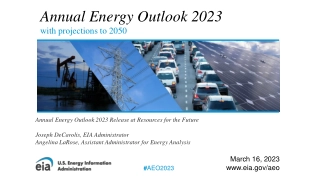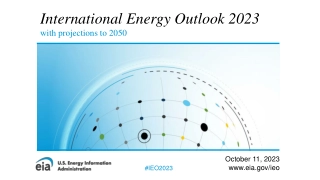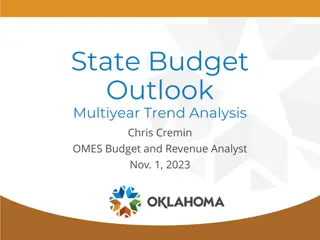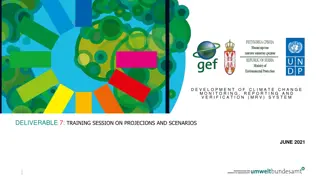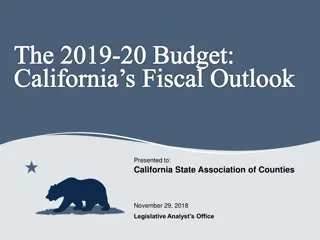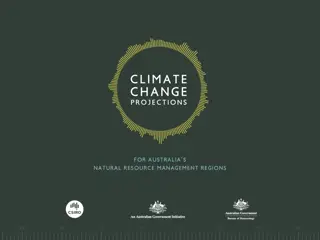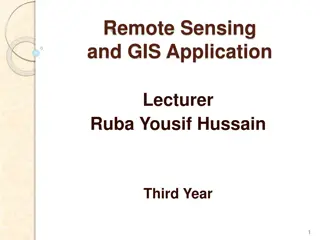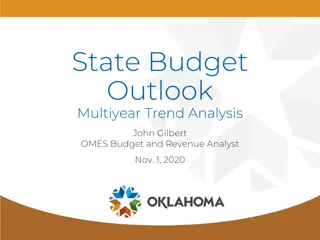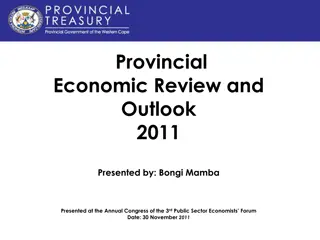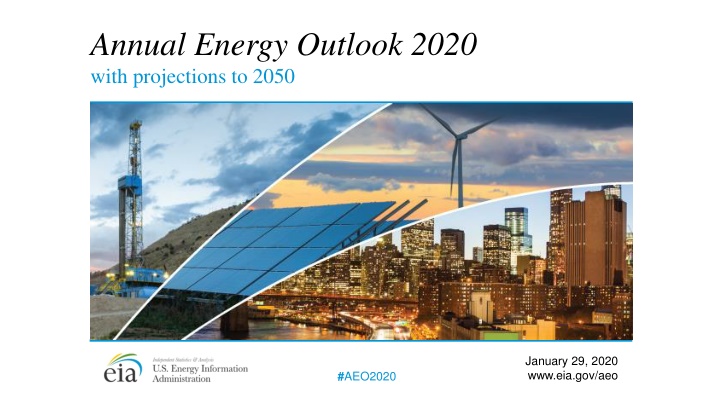
U.S. Energy Outlook 2020 Projections to 2050 - Key Takeaways
U.S. Energy Information Administration's Annual Energy Outlook 2020 explores long-term energy trends, highlighting projections and key assumptions for energy production and consumption in the United States. The report discusses trends in energy efficiency, electricity generation, renewables growth, coal and nuclear declines, crude oil and natural gas production, and carbon dioxide emissions. Uncertainties and modeling scenarios are also addressed, emphasizing the importance of understanding key assumptions underlying the projections.
Download Presentation

Please find below an Image/Link to download the presentation.
The content on the website is provided AS IS for your information and personal use only. It may not be sold, licensed, or shared on other websites without obtaining consent from the author. If you encounter any issues during the download, it is possible that the publisher has removed the file from their server.
You are allowed to download the files provided on this website for personal or commercial use, subject to the condition that they are used lawfully. All files are the property of their respective owners.
The content on the website is provided AS IS for your information and personal use only. It may not be sold, licensed, or shared on other websites without obtaining consent from the author.
E N D
Presentation Transcript
Annual Energy Outlook 2020 with projections to 2050 January 29, 2020 www.eia.gov/aeo #AEO2020
Annual Energy Outlook 2020 with projections to 2050 January 2020 U.S. Energy Information Administration Office of Energy Analysis U.S. Department of Energy Washington, DC 20585 This publication is on the Web at: https://www.eia.gov/aeo This report was prepared by the U.S. Energy Information Administration (EIA), the statistical and analytical agency within the U.S. Department of Energy. By law, EIA's data, analyses, and forecasts are independent of approval by any other officer or employee of the United States Government. The views in this report therefore should not be construed as representing those of the Department of Energy or other federal agencies. U.S. Energy Information Administration U.S. Energy Information Administration www.eia.gov/aeo 2 #AEO2020
Key Takeaways from U.S. Energy Information Administrations Annual Energy Outlook 2020 In the U.S. Energy Information Administration s (EIA) Annual Energy Outlook 2020 (AEO2020) Reference case, U.S. energy consumption grows more slowly than gross domestic product throughout the projection period (2050) as U.S. energy efficiency continues to increase. This decline in the energy intensity of the U.S. economy continues through 2050. The electricity generation mix continues to experience a rapid rate of change, with renewables the fastest-growing source of electricity generation through 2050 because of continuing declines in the capital costs for solar and wind that are supported by federal tax credits and higher state-level renewables targets. With slow load growth and increasing electricity production from renewables, U.S. coal-fired and nuclear electricity generation declines; most of the decline occurs by the mid-2020s. The United States continues to produce historically high levels of crude oil and natural gas. Slow growth in domestic consumption of these fuels leads to increasing exports of crude oil, petroleum products, and liquefied natural gas. After falling during the first half of the projection period, total U.S. energy-related carbon dioxide emissions resume modest growth in the 2030s, driven largely by increases in energy demand in the transportation and industrial sectors; however, by 2050, they remain 4% lower than 2019 levels. U.S. Energy Information Administration U.S. Energy Information Administration 3 #AEO2020 www.eia.gov/aeo
The Annual Energy Outlook explores long-term energy trends in the United States The value of the projections in the AEO2020 is not that they are predictions of what will happen, but rather, they are modeled projections of what may happen given certain assumptions and methodologies. By varying those assumptions and methodologies, AEO2020 can illustrate important factors in future energy production and use in the United States. Energy market projections are subject to much uncertainty because many of the events that shape energy markets as well as future developments in technologies, demographics, and resources cannot be foreseen with certainty. To illustrate the importance of key assumptions, AEO2020 includes a Reference case and side cases that systematically vary important underlying assumptions. EIA develops the AEO with the National Energy Modeling System (NEMS), an integrated model that captures interactions of economic changes and energy supply, demand, and prices. More information about the assumptions EIA used to develop these projections will be available on the AEO website shortly after the release of the AEO2020. The AEO is published to satisfy the Department of Energy Organization Act of 1977, which requires the Administrator of the U.S. Energy Information Administration to prepare annual reports on trends and projections for energy use and supply. U.S. Energy Information Administration U.S. Energy Information Administration 3 #AEO2020 www.eia.gov/aeo
What is the AEO2020 Reference case? The AEO2020 Reference case represents EIA s best assessment of how U.S. and world energy markets will operate through 2050, based on key assumptions intended to provide a base for exploring long-term trends. The AEO2020 Reference case should be interpreted as a reasonable baseline case that can be compared with the cases that include alternative assumptions. EIA based the economic and demographic trends reflected in the Reference case on the current views of leading economic forecasters and demographers. For example, the Reference case projection assumes improvement in known energy production, delivery, and consumption technologies. The Reference case generally assumes that current laws and regulations that affect the energy sector, including laws that have end dates, are unchanged throughout the projection period. This assumption makes it possible for us to use the Reference case as a benchmark to compare policy-based modeling. The potential effects of proposed legislation, regulations, or standards are not included in the AEO2020 cases. U.S. Energy Information Administration U.S. Energy Information Administration 4 #AEO2020 www.eia.gov/aeo
What are the side cases? Oil prices in the future will be driven by global market balances that are primarily influenced by factors that are not modeled in NEMS. In the AEO2020 High Oil Price case, the price of Brent crude oil, in 2019 dollars, reaches $183 per barrel (b) by 2050, compared with $105/b in the Reference case and $46/b in the Low Oil Price case. Compared with the Reference case, the High Oil and Gas Supply case reflects lower costs and greater U.S. oil and natural gas resource availability, which allows more production at lower prices. The Low Oil and Gas Supply case assumes fewer resources and higher costs. The effects of economic assumptions on the energy consumption modeled in the AEO2020 are addressed in the High Economic Growth and Low Economic Growth cases, which assume compound annual growth rates for U.S. gross domestic product of 2.4% and 1.4%, respectively, from 2019 to 2050, compared with 1.9% per year growth in the Reference case. AEO2020 introduces two cases to examine the sensitivities surrounding capital costs for electric power generating technologies. Capital cost reduction for an electric power generating technology is assumed to occur from learning by doing. In the High Renewables Cost case, no cost reduction from learning is assumed for any renewable technologies. The Low Renewables Cost case assumes higher learning for renewable technologies through 2050, resulting in a cost reduction of about 40% from the Reference case by 2050. U.S. Energy Information Administration U.S. Energy Information Administration www.eia.gov/aeo 6 #AEO2020

